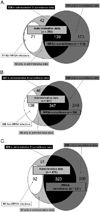Increasing burden of methicillin-resistant Staphylococcus aureus hospitalizations at US academic medical centers, 2003-2008
- PMID: 22759545
- PMCID: PMC3682488
- DOI: 10.1086/666640
Increasing burden of methicillin-resistant Staphylococcus aureus hospitalizations at US academic medical centers, 2003-2008
Abstract
Objective: The incidence of invasive methicillin-resistant Staphylococcus aureus (MRSA) infections in the United States decreased during 2005-2008, but noninvasive community-associated MRSA (CA-MRSA) infections also frequently lead to hospitalization. We estimated the incidence of all MRSA infections among inpatients at US academic medical centers (AMCs) per 1,000 admissions during 2003-2008.
Design: Retrospective cohort study.
Setting and participants: Hospitalized patients at 90% of nonprofit US AMCs during 2003-2008.
Methods: Administrative data on MRSA infections from a hospital discharge database (University HealthSystem Consortium [UHC]) were adjusted for underreporting of the MRSA V09.0 International Classification of Diseases, Ninth Revision, Clinical Modification code and validated using chart reviews for patients with known MRSA infections in 2004-2005, 2006, and 2007.
Results: The mean sensitivity of administrative data for MRSA infections at the University of Chicago Medical Center in three 12-month periods during 2004-2007 was 59.1%. On the basis of estimates of billing data sensitivity from the literature and the University of Chicago Medical Center, the number of MRSA infections per 1,000 hospital discharges at US AMCs increased from 20.9 (range, 11.1-47.7) in 2003 to 41.7 (range, 21.9-94.0) in 2008. At the University of Chicago Medical Center, among infections cultured more than 3 days prior to hospital discharge, CA-MRSA infections were more likely to be captured in the UHC billing-derived data than were healthcare-associated MRSA infections.
Conclusions: The number of hospital admissions for any MRSA infection per 1,000 hospital admissions overall increased during 2003-2008. Use of unadjusted administrative hospital discharge data or surveillance for invasive disease far underestimates the number of MRSA infections among hospitalized patients.
Figures

Comment in
-
Increasing rates of methicillin-resistant Staphylococcus aureus in academic hospitals: a result of active surveillance?Infect Control Hosp Epidemiol. 2013 Jan;34(1):105-6. doi: 10.1086/668797. Infect Control Hosp Epidemiol. 2013. PMID: 23221204 No abstract available.
-
Reply to Lewis et al.Infect Control Hosp Epidemiol. 2013 Jan;34(1):106-7. doi: 10.1086/668798. Infect Control Hosp Epidemiol. 2013. PMID: 23221205 No abstract available.
References
-
- Lowy FD. Staphylococcus aureus infections. N Engl J Med. 1998;339:520–532. - PubMed
-
- Jevons MP. “Celbenin”-resistant Staphylococci. BMJ. 1961;1:124–125.
-
- Herold BC, Immergluck LC, Maranan MC, et al. Community-acquired methicillin-resistant Staphylococcus aureus in children with no identified predisposing risk. JAMA. 1998;279:593–598. - PubMed
-
- Naimi TS, LeDell KH, Como-Sabetti K, et al. Comparison of community- and health care-associated methicillin-resistant Staphylococcus aureus infection. JAMA. 2003;290:2976–2984. - PubMed
-
- David MZ, Glikman D, Crawford SE, et al. What is community-associated methicillin-resistant Staphylococcus aureus? . J Infect Dis. 2008;197:1235–1243. - PubMed
Publication types
MeSH terms
Grants and funding
LinkOut - more resources
Full Text Sources
Medical
